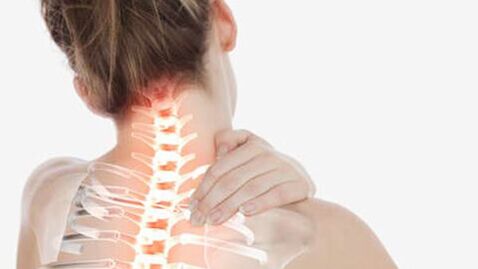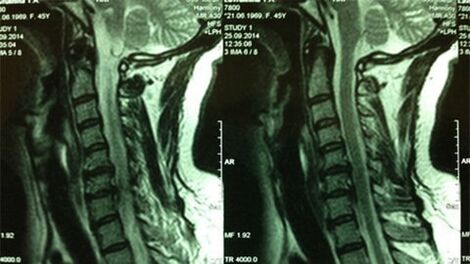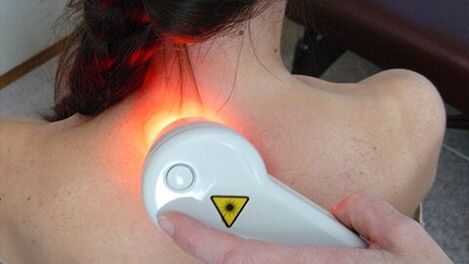
Cervical osteochondrosis is a progressive degenerative process, which leads to the exhaustion, deformation and destruction of the intervertebral discs of the cervical region.The loss of cartilage that absorbed the shock causes pain both due to the exposure of the joint surfaces (spondularosis), and due to the improvement of the nerve roots of the spinal cord.
In the absence of timely treatment, it is possible to ignite the spine with the loss of its natural flexibility, compromised the flow of blood to the brain, the deterioration of nervous conduction in those parts of the body that innervate the roots of the cervical column.
The pathology can develop both independently and as part of a general damage to the spine with the coverage of the chest, the lumbar and sacral parts.
General information
It is believed that the osteochondosis of the cervical column is more common than in other departments.In reality, this is not the case - the dystrophic phenomena develop uniformly in all points of the maximum load - in the area of the main curves of the spinal column (the lower the department is, the greater the load that transports).However, the symptoms of cervical osteocondrosis are more pronounced, therefore they seem more frequent.This is due to the high mobility of the neck vertebrae, which at the same time keep the head, as well as with the peculiarity of the exits of the rotating roots of the spinal cord.
Note!According to statistics, the disease affects over 60% of medium and elderly people.However, recently, a rejuvenation of the pathological process has been observed: the pathology is found in young people and even in teenagers.This is due to the general information of study and work, as well as a decrease in physical activity and a deterioration of the quality of nutrition.
Given the age of age, 2 forms of cervical osteochondrosis can be distinct: physiological and pathological.
Physiological processIt is associated with the natural aging of the body, when the symptoms of the disease are a consequence of the gradual wear of the intervertebral discs.The process occurs under the influence of the endocrine system and is a consequence of menopause.The destruction of cartilage structures begins from the center of the intervertebral disc and is accompanied by a gradual replacement of the fabrous cartilage tissue.The pathology is irreversible, however, can be compensated for special medicines.
Pathological processIt is associated with abnormal destructive changes in the body: immune, dystrophic, inflammatory, metabolic.First of all, the subcutaneous tissues involved in salts on bone structures appear, the nerve roots are inflamed, the hypertonicity of the atrophic or skeletal muscle occurs, which leads to circulatory disorders in adolescence.With a timely diagnosis, the pathology is treated and ends with the complete restoration of the healthy function of organs and fabrics.
Phase of cervical osteochondosis and their symptoms
There are 4 main phases of the pathological process:
- 1st stage-is expressed by a slight discomfort and muscle overtention in the sick region, cartilage records lose their stability;
- The 2nd pain-room appears, especially with the movements of the head.The intervertebral discs are deformed, the fibrous ring begins to collapse, the distance between the vertebrae is reduced;
- 3rd stage: pain intensifies and becomes constant, the movement becomes limited.The head heads can cause dizziness attacks, nausea, a violation of the blood supply to the brain leads to general lethargy, rapid fatigue, compromised concentration, the cartilage tissue is thinner, the vertebrae is closed, the fibrous ring is completely destroyed with the emergency of the risk of intervertebral hernia;
- The 4th stage-the pain syndrome completely immobilizes the neck area, the blood circulation of the brain is disturbed and requires constant support of drugs, the vertebrae begin to grow together.
Cervical osteochondrosis: signs, symptoms of pathology
In the early stages, osteochondosis is asymptomatic.As the disease develops, a distinctive feature is the presence of painful or uncomfortable sensations in the head, in the neck and chest, less often the upper limbs.
All possible symptoms can be attributed conditioned to 4 types of syndromes: heart, vertebral, real (nervous) and spinal artery syndrome (with circulatory disorders).
Vertebrate syndrome:
- crunch in the neck when turning/tilt heads;
- With the progress of the disease, pain and difficulty of movement occur;
- Morphological disorders of the structure in the body of the vertebra and the intervertebral space (visible on the X -ray).
Heart syndrome:
- lack of breath, weakness;
- An incomplete feeling of breath, lack of air;
- Spontaneous phenomena from the cardiovascular system-angola pectis, rag pain, burning;
Rook syndrome:
- numbness of the language, shoulders, fingers, of the occipital region;
- Difficulty with swallowing;
- Unpleasant sensations in the area between the shoulder blades;
- Headache in the neck and forehead.
Vail artery syndrome:
- unreasonable jumps to blood pressure;
- vertigo, up to the loss of consciousness;
- noise in the ears, a sensation of cotton wool in the head;
- temporary blindness, "flies" in the eyes;
- Periodic attacks of nausea, especially when it goes;
- headache - mainly in the neck, as well as migraine;
- Downtime, decrease in performance, memory, concentration of attention, depression.
Attention!All these syndromes should be combined with each other.The absence of symptoms of one of them can be a reason for differential diagnosis with other groups of diseases.
The causes of cervical osteochondosis
The diaostrophic phenomena in the cervical column are associated with the vertical position of the skeleton and the specific distribution of static and dynamic loads, which largely depend on the predominant poses and the degree of development of the skeletal muscles.
The main reasons:
- The lack of movement - what does not develop - degrades: the muscles weaken, the fabrics are destroyed;
- Early static poses - muscle terminals lead to circulatory disorders with subsequent tissue dystrophy;
- Lack of nutrition or unbalanced diet: the body should receive everything necessary for the construction and renewal of the bone structures and cartilage of the skeleton, keeping muscle tone;
- Obesity, overweight, wear weights: the load on the skeleton structure increases;
- constant nervous tension and nervous stress;
- The hypothermia of the cervical region - "captured", "inflated" - causes hidden inflammatory processes;
- The presence of autoimmune diseases with the involvement of the cartilage tissue leads to its premature destruction;
- Endocrine pathologies are confused by mineral metabolism, reduce calcium, silicon, phosphorus and other elements of bone chryshot tissue;
- lesions of the cervical region;
- Congenital anomalies of the spine and adjacent muscles.
Diagnostics

The diagnosis of "osteochondosis of the cervical vertebra" is made up of the low specificity of the symptoms and a wide variety of their manifestations.In the examination process, a consultation of a neurologist, surgeon, orthopedist, cardiologist will be requested.
A physical exam is carried out by a doctor with a patient survey.The main diagnostic load resides with instrumental and laboratory research methods.
Instrumental diagnostics:
- X -Rings of the Cervical Department;In the initial phase of the process, the magnetic resonance imaging of the cervical department will be more instructive - will guarantee a high quality display of solid and soft tissues - will show the condition of the intervertebral discs, the presence of osteophytes, the deformations, the damage to the nerve roots and the blood vessels;will evaluate the condition of ligaments, muscles, bone tissue;
- Ultrasound shows the dynamic state of soft tissues;
- The dopplerography of the neck vessels will help to evaluate the hemodynamics and the degree of damage to the blood vessels (in particular the state of the spinal artery);
- Contrasting myelography - will help with suspicion of violation of the nerve processes;
- The ECG and the echocardiography of the heart are used for the differential diagnosis of cardiac syndrome with cardiovascular diseases.
How to treat cervical osteochondosis
The complex of medical measures is formed taking into account the stadium of the disease (acute, chronic), the degree of damage and the causes of the development of the pathology.Use a conservative treatment, surgery, mixed approach.
Conservative effect
It is a restoration or gradual compensation for damage against the background of symptomatic treatment.It includes drug therapy, physiotherapy, exercise therapy and massage methods.
Pharmacological treatment:
- Painkilling - mainly gel and ointments of local influence;In serious cases - common painkillers in the form of tablets;
- Anti -inflammatory drugs - NSAIDs and corticosteroids (short route, if necessary);
- Medicines to improve microcirculation and blood circulation in general;
- Condroprotectors - means to protect and restore the cartilage tissue;
- Musorelaxants - to eliminate muscle terminals and spasms;
- Vitamin and microelene complexes are needed for nutrition and support of fabrics by building elements.
As the acute symptoms are weakened, the methods of physiotherapy, operating therapy and cars -imassages are connected.
Therapeutic gymnasticsIt improves the feeding of cartilage and bone tissues restoring the flow of blood into the damaged area.In order to avoid complications, it is recommended to use the method of isometric movements, when instead of real rpm and inclinations of the head that can damage, they use their imitation.
Attention!All actions should only be performed after diagnosis and consultation with a doctor.
The technique allows you to develop and strengthen the muscles of the short neck atrophied and stabilize the position of the cervical column.The sequence of basic exercises:
- The palm of the right hand is reduced to the lateral surface of the head of the palm on the head within 10 seconds, while trying the muscles of the head and neck for resistance: the head should remain motionless.
- Lower your hand, relax the head and neck muscles as much as possible for 20 seconds.
- Repeat the exercise with the left hand.
- Put both hands with the palms of the palm trees in the press on the forehead for 10 seconds, as if tried to refuse the back, striving the muscles of the neck to resist the movement.The head should remain motionless.
- Lower your hands, relaxing the muscles similarly to the previous year.
- Put both palms in the area above the back of the head.By analogy, perform a pressing load on the neck muscles, trying to tilt your head forward: it should still be immobile.
- Lower your hands, relax the neck and muscles of the head.Repeat the set of exercises 4-10 times.
After strengthening the short neck muscles, you can start performing dynamic exercises.
Note!As a methodology to restore the mobility of the cervical region, water and water gymnastics have proven well.
Car -massageIt allows you to reduce the intensity of local reactions and remove muscle terminals during static work.Rules for execution:
- Exposure area: the rear part of the head, the rear and lateral surfaces of the neck;
- perform the procedure in the sitting position;
- The movements should be performed in the direction by the spine;
- use only fingers;
- Avoid pressure on inflamed areas;
- Perform movements without hitches: strong pressure can damage.

PhysiotherapyFeature for hospital treatment and rehabilitation of sanatorium-resort.Well shown themselves:
- The electrophoresis - listens to the area, improves microcirculation, is used for a deeper penetration of local drugs;
- magnetotherapy;
- amplipulse;
- Uhf.
The surgery is indicated with complicated extrusion, violations of the spinal cord and unconscious pain syndromes.
Cervical osteochondosis is dangerous
The neck area concentrates the dense intertwining of the main blood vessels, the nerve processes and dynamic structures of the bone skeleton.In the absence of treatment, serious pathological changes can be observed:
- The weakening of the fibrous ring causes dislocations and subluxation in the area of the most mobile vertebrae;
- The presence of osteophytes and the spasm of the muscles leads to the violation of the nerve roots and blood vessels with the formation of compression syndromes;
- The destruction of cartilaginous discs and the rapprochement of the vertebrae lead to intervertebral hernias with violation of the nervous tissue.
Each of this phenomenon follows a pronounced negative reaction from the whole body.
Possible complications and consequences
The list of the most common complications of cervical osteochondosis can be included:
- Vegetable dystonia;
- hypertension;
- hunger for brain oxygen and its structures;
- Ocular retina dystrophy with visual impairment;
- failure of the thyroid;
- Interruption of the functions of esophagus and trachea - difficulty swallowing and breathing cramps;
- Unconscious pain syndrome in the head, neck, chest, higher end;
- convulsions and numbness of the face, hands;
- Hypotalam-pituitary system disorders that attracts a failure of the entire hormonal activity of the body.
Preventive measures
The most effective treatment is the prevention of the disease.Prevention will help you in this.Just follow several basic recommendations:
- Regulate your posture
- create a convenient workplace;
- During the sedentary work, take breaks on physical education ";
- Include in your dietary foods rich in calcium, magnesium, phosphorus, silicon - fish, walnuts, seeds, legumes, dairy products -caseari, fresh vegetables, fruit;Limit the consumption of salt, sweet, flour and sharp dishes;
- To sleep and rest, use the orthopedic cushion and pillow;
- Take care of a sport -side sport: it is better to give the preference to swimming.
Although you are not able to take into account all requirements, moderate physical effort, adequate diet and a careful attitude towards posture can significantly reduce the risk of pathology.




































